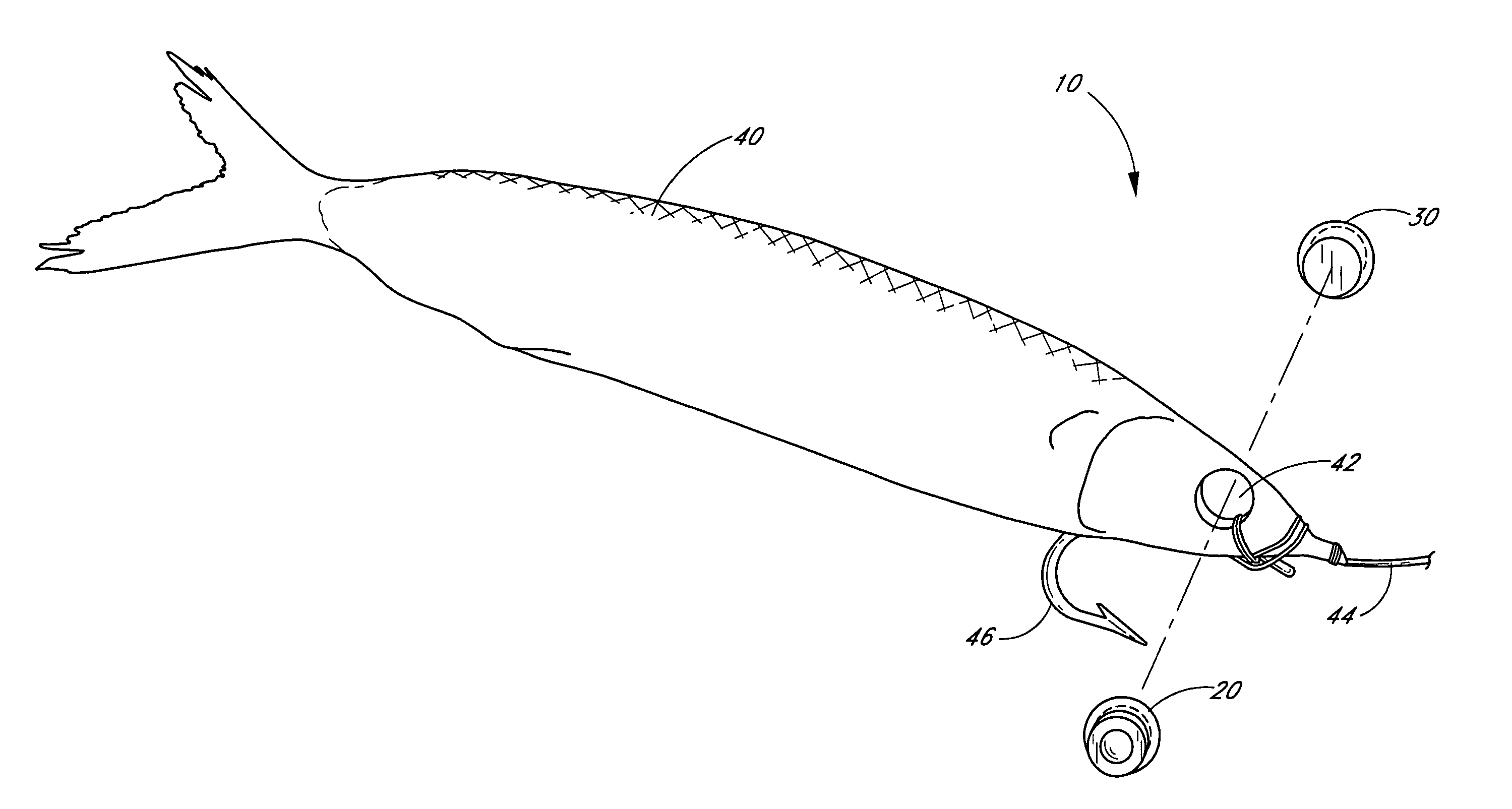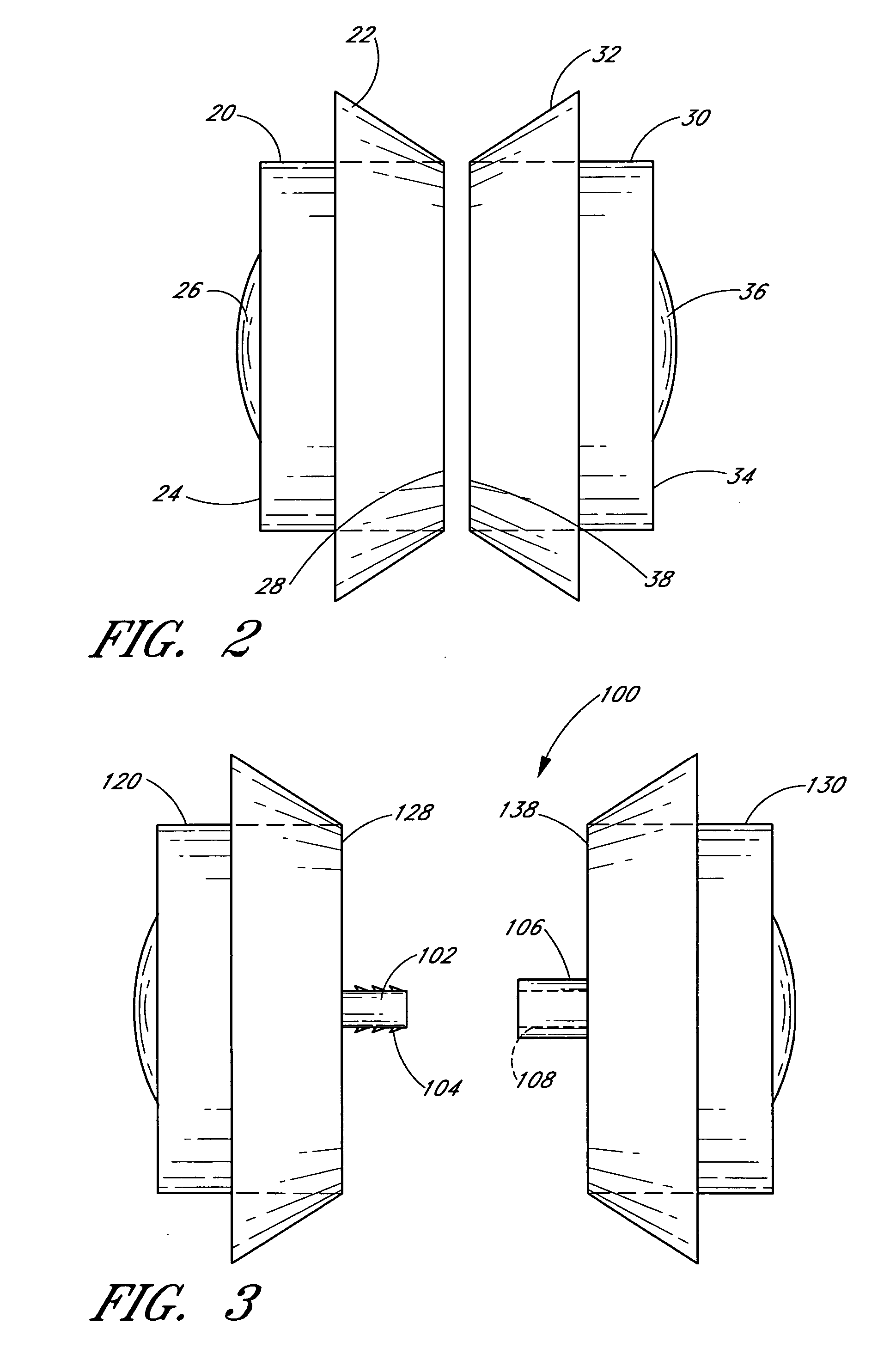Artificial eye assembly for improving the hydrodynamic performance and attractiveness of a trolled baitfish
- Summary
- Abstract
- Description
- Claims
- Application Information
AI Technical Summary
Benefits of technology
Problems solved by technology
Method used
Image
Examples
second embodiment
[0041] With reference now to FIG. 3, an artificial eye assembly 100 comprises a first eye member 120 and a second eye member 130, wherein a mechanical coupling mechanism is provided for coupling the first and second eye members together during installation. In the illustrated embodiment, the mechanical coupling mechanism comprises an elongate extension 102 protruding from an inner side 128 of the first eye member 120 and a tubular member 106 protruding from an inner side 138 of the second eye member 130. The tubular member 106 is provided with a central hole 108 for receiving the extension 102 in a snug fit. The extension 102 and tubular member 106 thus form a male-female locking assembly. To further strengthen the connection between the extension 102 and the tubular member 106, the extension 102 may be formed with ribs or barbs 104 shaped for maintaining the extension 102 in the hole 108 and resisting backward movement.
[0042] In one advantageous feature of this embodiment, the exte...
third embodiment
[0043] With reference now to FIGS. 4A and 4B, an artificial eye assembly 200 comprises a substantially cylindrical member 210 having a first end 220 and a second end 230. First and second eye portions are disposed along the first and second ends, respectively, to resemble natural eyes. The cylindrical member 210 is a single unit sized for insertion into the transverse channel in the fish's head such that the simulated eyes on the first and second ends 220, 230 are visible on opposite sides of the fish's head in a natural location. Although a cylindrical member is a preferred shape, a wide variety of unitary members may be used with this embodiment. With particular reference to FIG. 4A, an attachment mechanism is provided for securing the cylindrical member 210 in the head after insertion. In one preferred embodiment, the attachment mechanism takes the form of a pin 240 that is insertable through the fish's head into the cylindrical member 210. The cylindrical member may be formed wi...
fourth embodiment
[0046] With reference now to FIGS. 6A and 6B, an artificial eye assembly 300 comprises another substantially cylindrical member 310 having a first end 320 and a second end 330. In this embodiment, an attachment mechanism is provided in the form of an upper pair of wires 340, 342, and a lower pair of wires 350, 352. The upper pair includes a first wire 340 extending from a first side 320 and a second wire 342 extending from a second side 330. Similarly, the lower pair includes a first wire 350 extending from a first side 320 and a second wire 352 extending from a second side 330. The first and second wires in each pair may be separate components or may be part of a single wire that extends through the cylindrical member 310. Each of the wires may, for example, be a copper wire having a small diameter. As illustrated in FIG. 6B, each of the wires is formed with sufficient length such that the upper pair of wires may be twisted together above the head and the lower pair of wires may be...
PUM
 Login to View More
Login to View More Abstract
Description
Claims
Application Information
 Login to View More
Login to View More - R&D Engineer
- R&D Manager
- IP Professional
- Industry Leading Data Capabilities
- Powerful AI technology
- Patent DNA Extraction
Browse by: Latest US Patents, China's latest patents, Technical Efficacy Thesaurus, Application Domain, Technology Topic, Popular Technical Reports.
© 2024 PatSnap. All rights reserved.Legal|Privacy policy|Modern Slavery Act Transparency Statement|Sitemap|About US| Contact US: help@patsnap.com










